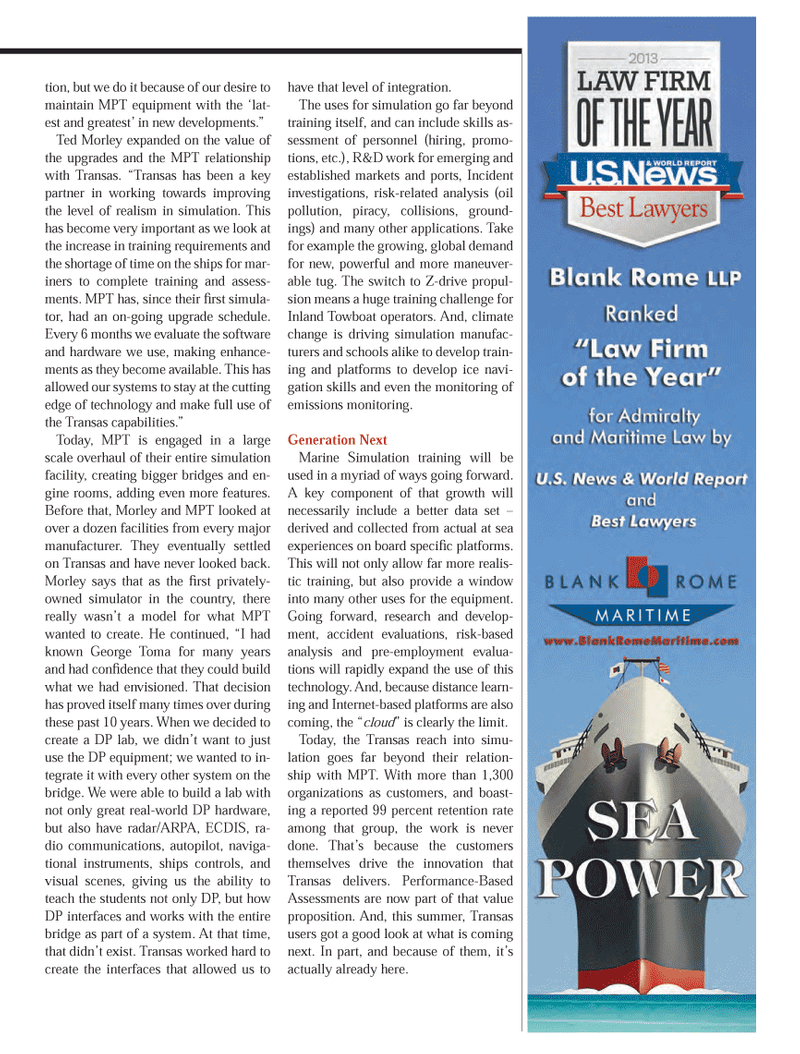
Page 49: of Maritime Logistics Professional Magazine (Q3 2013)
Training & Security
Read this page in Pdf, Flash or Html5 edition of Q3 2013 Maritime Logistics Professional Magazine
tion, but we do it because of our desire to maintain MPT equipment with the ?lat-est and greatest? in new developments.? Ted Morley expanded on the value of the upgrades and the MPT relationship with Transas. ?Transas has been a key partner in working towards improving the level of realism in simulation. This has become very important as we look at the increase in training requirements and the shortage of time on the ships for mar- iners to complete training and assess-ments. MPT has, since their rst simula- tor, had an on-going upgrade schedule. Every 6 months we evaluate the software and hardware we use, making enhance- ments as they become available. This has allowed our systems to stay at the cutting edge of technology and make full use of the Transas capabilities.? Today, MPT is engaged in a large scale overhaul of their entire simulation facility, creating bigger bridges and en- gine rooms, adding even more features. Before that, Morley and MPT looked at over a dozen facilities from every major manufacturer. They eventually settled on Transas and have never looked back. Morley says that as the rst privately- owned simulator in the country, there really wasn?t a model for what MPT wanted to create. He continued, ?I had known George Toma for many years and had con dence that they could build what we had envisioned. That decision has proved itself many times over during these past 10 years. When we decided to create a DP lab, we didn?t want to just use the DP equipment; we wanted to in- tegrate it with every other system on the bridge. We were able to build a lab with not only great real-world DP hardware, but also have radar/ARPA, ECDIS, ra- dio communications, autopilot, naviga- tional instruments, ships controls, and visual scenes, giving us the ability to teach the students not only DP, but how DP interfaces and works with the entire bridge as part of a system. At that time, that didn?t exist. Transas worked hard to create the interfaces that allowed us to have that level of integration. The uses for simulation go far beyond training itself, and can include skills as-sessment of personnel (hiring, promo-tions, etc.), R&D work for emerging and established markets and ports, Incident investigations, risk-related analysis (oil pollution, piracy, collisions, ground- ings) and many other applications. Take for example the growing, global demand for new, powerful and more maneuver- able tug. The switch to Z-drive propul- sion means a huge training challenge for Inland Towboat operators. And, climate change is driving simulation manufac- turers and schools alike to develop train- ing and platforms to develop ice navi- gation skills and even the monitoring of emissions monitoring. Generation NextMarine Simulation training will be used in a myriad of ways going forward. A key component of that growth will necessarily include a better data set ? derived and collected from actual at sea experiences on board speci c platforms. This will not only allow far more realis- tic training, but also provide a window into many other uses for the equipment. Going forward, research and develop- ment, accident evaluations, risk-based analysis and pre-employment evalua- tions will rapidly expand the use of this technology. And, because distance learn- ing and Internet-based platforms are also coming, the ?cloud? is clearly the limit.Today, the Transas reach into simu- lation goes far beyond their relation- ship with MPT. With more than 1,300 organizations as customers, and boast- ing a reported 99 percent retention rate among that group, the work is never done. That?s because the customers themselves drive the innovation that Transas delivers. Performance-Based Assessments are now part of that value proposition. And, this summer, Transas users got a good look at what is coming next. In part, and because of them, it?s actually already here. MP #3 34-49.indd 49MP #3 34-49.indd 499/10/2013 10:22:44 AM9/10/2013 10:22:44 AM

 48
48

 50
50
